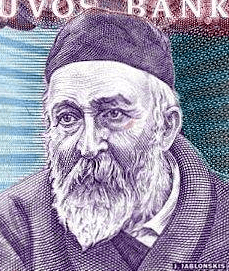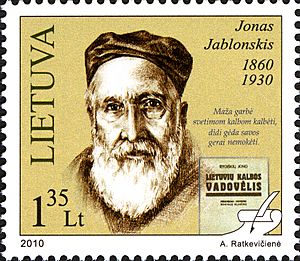Jonas Jablonskis facts for kids

Jonas Jablonskis (born December 30, 1860, in Kubilėliai; died February 23, 1930, in Kaunas) was a very important Lithuanian language expert. He is known as one of the main people who created the standard Lithuanian language we use today. He often used the pen name Rygiškių Jonas, which came from Rygiškiai, a small town where he grew up.
Contents
Jonas Jablonskis: Early Life and Education
Jonas Jablonskis finished school at Marijampolė Gymnasium. After that, he studied old languages like Greek and Latin. He went to the University of Moscow from 1881 to 1885.
Some of his teachers, like Phillip Fedorovich Fortunatov, knew about the Lithuanian language. They encouraged Jablonskis to study his own native language.
Starting His Career
After finishing his studies in 1885, Jablonskis faced a problem. The Russian government had a policy called russification. This meant they tried to make everyone in the Russian Empire speak Russian and follow Russian culture.
Because Jablonskis was Lithuanian and Catholic, he could not find a teaching job in Lithuania. For a while, he gave private lessons. He also worked as a clerk in a court in Marijampolė.
In 1889, he finally got a job. He became a teacher of Greek and Latin at Jelgava Gymnasium in Latvia. He taught there until 1896.
His home in Jelgava became a popular meeting spot. Many educated Lithuanians would gather there. During his summer breaks, Jablonskis traveled around Lithuania. He collected information about the language from people who spoke it every day. This helped him with his language studies.
Promoting Lithuanian Culture
Jablonskis met Antanas Chodakauskas through Antanas's niece, Gabrielė Petkevičaitė. The Chodakauskas and Jablonskis families became very good friends. Jablonskis often spent his summers with the Chodakauskases.
Jablonskis was a strong supporter of the Lithuanian language and culture. His passion soon inspired the Chodakauskas family. One day, Antanas Chodakauskas's daughter, Jadvyga, asked Jablonskis, "Who am I?" Jablonskis replied, "Well, how do you feel?" Jadvyga said, "I feel Lithuanian." Jablonskis then exclaimed, "That's it!"
Chodakauskas invited Lithuanian students to teach his children. Jablonskis recommended these students. In the summer of 1895, Jablonskis suggested Antanas Smetona (1874-1944) as a tutor. Smetona was a student of Jablonskis. He tutored Romanas, Chodakauskas’s son, who was getting ready for entrance exams. Smetona came from a poor farming family and needed the work. At the Chodakauskas manor, Antanas Smetona met his future wife, Sofija Chodakauskaitė.
Moving Around for His Work
The Russian authorities did not like Jablonskis's work for Lithuanian causes. Because of this, they made him move to Tallinn, Estonia.
Later, the Russian Academy of Sciences asked Jablonskis to edit a dictionary. This dictionary was started by Antanas Juška, who had recently passed away. This work led to Jablonskis being fired from his teaching job in Tallinn in 1901. The next year, he was banned from Lithuania.
Even with these problems, he kept working on the dictionary in Pskov, Russia. During this time, he started writing his book Lietuviškos kalbos gramatika (Lithuanian Grammar, 1901). He used another pen name, Petras Kriaušaitis. The Russian authorities did not allow Lithuanian books to be printed using the Latin alphabet. So, his grammar book was later published in Tilsit, East Prussia.
Return to Lithuania
Jablonskis was finally allowed to return to Lithuania in 1903. He went to Šiauliai and then to Vilnius in 1904. In 1904, the ban on printing Lithuanian books was lifted. After this, he worked on the editorial teams for newspapers. These included Vilniaus žinios (Vilnius News) and Lietuvos ūkininkas (Lithuanian Farmer). He also edited publications for Aušra (The Dawn).
From 1906 to 1908, he taught at the Pedagogic Seminary of Panevėžys. He faced money problems, which made him move to Brest, Belarus in 1908. He taught there until 1912, when he was moved to Hrodna.
When World War I began, his entire school was moved to Velizh, Russia. From 1915 to 1918, he taught at a gymnasium for Lithuanian refugees in Voronezh. After this, he returned to Vilnius. By then, he was almost completely disabled and needed a wheelchair.
When Poland took control of Vilnius in 1919, the Lithuanian government brought him to Kaunas. The University of Lithuania in Kaunas opened in 1922. Jablonskis was made an honorary professor and taught Lithuanian there until 1926.
At the same time, he wrote textbooks for schools. He also translated books and edited translations of books from other languages. He joined groups that worked to make Lithuanian words and spelling (called orthography) more consistent. He also wrote reviews of books about language study (called philology).
Jonas Jablonskis passed away in Kaunas on February 23, 1930. He was buried in the Petrašiūnai Cemetery.
Jonas Jablonskis: Contributions to the Lithuanian Language
Jablonskis's biggest achievement was helping to create the standard Lithuanian language. In his book Lietuviškos kalbos gramatika, he was the first to explain the main ideas for how standard Lithuanian should develop.
Developing Standard Lithuanian
Jablonskis suggested basing the Lithuanian language on the western Aukštaitijan dialect. A dialect is a form of a language spoken in a certain area. Other language experts had used the dialect of Prussian Lithuanians.
Jablonskis chose the Aukštaitijan dialect because it was the living speech of the people. It had kept many old words and grammar rules. This dialect was also less affected by foreign languages. At that time, the written Lithuanian language had many foreign words, especially from Slavic languages. Jablonskis worked hard to make the Lithuanian language pure again.
Impact of His Work
Jablonskis worked for fifty years on the Lithuanian language. His efforts led to several important changes:
- Differences in spelling (orthography) were greatly reduced.
- Many unnecessary foreign words (called loan words) were replaced with proper Lithuanian words.
- New words (called neologisms) were created following Lithuanian rules.
- The grammar, especially how sentences are put together (called syntax), became much more organized and consistent in written Lithuanian.
Jonas Jablonskis was a practical language expert. He wrote books to help people use the language better. Some of his works include:
- Lietuvių kalbos sintaksė (Lithuanian Syntax), 1911
- Rašomosios kalbos dalykai (Matters of Literary Language), 1912
- Lietuvių kalbos gramatika (Lithuanian Grammar), last edition 1922
- Lietuvių kalbos vadovėlis (Textbook of Lithuanian), 1925
- Linksniai ir prielinksniai (Cases and Prepositions), 1929
His most important work was Lietuvių kalbos gramatika. For a long time, this was the only full guide for schools and the public. He also helped purify the language by writing many articles. In these articles, he pointed out grammar and sentence structures that were not truly Lithuanian. He also translated popular science and educational books by authors like M. Bogdanov, Ivan Krylov, Samuel Smiles, and George Sand.
Many of Jablonskis's works were meant to be practical. However, they are still important for language study today. The language information he collected was used in the 20 volumes of the Academic Dictionary of Lithuanian. This information is still used in research and when editing texts and books. He also introduced the letter ū into Lithuanian writing.



